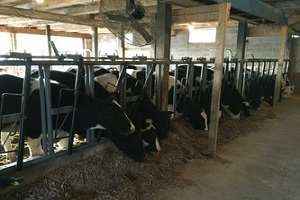In a news article posted here on July 27 readers learned how recent market conditions have revitalized the interest in feeding dairy steers for beef. Read how one family has approached their entry into just such a feeding venture.
Two years ago Steve Sechrist, looking at his empty barn, decided to make a change. Previously Sechrist, who, with his brothers Mark and Todd and father Ernest, operate Sechrist Dairy Farm in Cogan Station, PA, had been custom raising dairy heifers. When the last group of 25 left the barn Sechrist weighed several factors.

Holstein steers on feed at the Sechrist farm.
Mulling over the fact that “it didn't like look like milk prices were going to stay high, beef’s high right now, the cost for me to buy heifers is going to be higher, and I know I can buy Holstein steers from local farmers,” Steve knew that feeding Holstein steers was a possibility, but “how do I raise them in a profitable way?” he asked himself.
On the family-owned farm, comprised of about 250 tillable acres, Ernest and Todd operate the dairy while Steve and Mark have been raising heifers together for years. “There are multiple divisions on the farm within one farm,” said Sechrist. “We all share equipment and do all the fieldwork together. Our farm was never big enough for me to join it with being such a small dairy farm” so Sechrist began a construction business, Sechrist Construction and Remodeling, Inc. “I was looking for a way, as my dad was aging, find a way to profitably stay involved on the farm,” said Sechrist, “and not take money from the construction business.”
Experienced with growing heifers out in the pasture, Sechrist wasn’t familiar with finishing steers for beef. Over the years, he had experimented with putting several Holstein steers in with heifers to grow out for beef. “That was the situation that was frustrating, how long it would take to finish the steers in the same feed program as the heifers,” said Sechrist. Consequently, when some online research yielded an upcoming demonstration at Ag Progress Days about feeding Holstein steers, he decided to attend.
That demonstration, which took place in 2015, proved to be eye-opening. “When they told me I could actually finish a steer in 16 months, that really sparked my interest,” said Sechrist, “because it was taking me at least 22 months to finish them.” The seminar ended up being a turning point. “I was typing on my phone the whole time,” said Sechrist. “I still have the email I sent myself.”
During the seminar, presenters recommended getting in touch with a nutritionist, which Sechrist did.
“Hearing what they said at the seminar and then speaking to a nutritionist like they recommended, then a year later seeing the results of the calves, I can see how these animals are actually going to finish out at 16 months with the high protein diet,” said Sechrist. With that ration, Holsteins tend to stay shorter-framed “so once they’re done growing you can finish them out,” he said. “Although they’re not going to finish at 1,800 pounds they’ll finish so much more quickly and yield a higher quality meat.”
Additionally, “now we have scales and we’re shooting for four pounds of growth a day, so we’re planning to weigh them every 30 days,” he said, “so we can critique them and see if we’re hitting our goals.”
Also, Sechrist found that “the old mindset of raising cows had to change,” he said. The nutritionist was “telling me that I could raise calves and not feed them a piece of hay, and even my family was thinking that I’m crazy not giving them hay, when we always have this cheap feed sitting there,” he said. “We have lots of corn though, too, so I was confident that we'd have enough feed to transition to feeding that way.” A solution did present itself however, in the form of Angus brood cows. By adding the cows - he’s up to 13 this year - Sechrist was able to utilize both the pasture and the hay that is so readily available on the farm.
With his father milking about 40 cows on the home farm, Sechrist had a source for a few, but not all, of the calves he needed to fill the barn. Over time, Sechrist has found it helpful to cultivate a relationship with several local dairy farmers to source his calves. “I pay a couple bucks extra and they guarantee to start them on colostrum.”
When he returned to 2016 Ag Progress Days and again attended the demonstration on how to feed Holsteins, Sechrist learned that “in order to get optimal growth, you need to consider doing implants.” Sechrist, said he has already purchased implants and is planning to attend a local beef production workshop to learn how to administer them.
Now, with his first group of 25 steers in the finishing pen, Sechrist is hopeful about the new Holstein-feeding venture. “I’m very grateful for the programs that are out there,” said Sechrist. “And then to have the follow-up programs...the proof’s been in the pudding with how great the calves are looking, they are nice short steers coming, their body shape is like nothing I've ever raised before. They’re filling out.”
Source: psu.edu